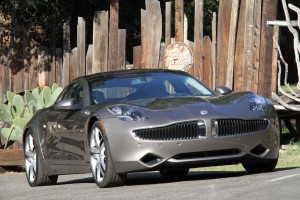
It remains to be seen who - if anyone - will put the Fisker Karma plug-in hybrid back into production.
Only a handful of employees still report to work at the Fisker Automotive offices in Anaheim, California, and it has been more than a year since any of the failed maker’s Karma sedans have rolled off the assembly line at a plant in Finland. But the once-promising battery-car maker could get a new lease on life later this week.
Or, more precisely, a new owner could find ways to use Fisker’s assets, which include a second, partially completed plug-in hybrid, as well as a never-completed plant in Delaware. They’ll be auctioned off on Friday, October 11th in a move by the U.S. Department of Energy to recover $168 million in loans from a controversial government program intended to help spur the development of alternatively powered vehicles.
Who will be bidding for the remains of the carmaker is unclear, but since Fisker collapsed last spring several names have been said to be interested. That includes former Chrysler and General Motors executive Bob Lutz, Wanxiang, the Chinese company that purchased Fisker’s battery supplier, the former A123 – now renamed B456 – and Richard Li, a Hong Kong billionaire. The company’s founder, Henrik Fisker, had also expressed interest in repurchasing the eponymously named automaker though it is unclear he has been able to line up any financial backing.
As recently as 2011, Fisker Automotive seemed one of the most promising of a new flock of contenders who hoped to challenge the established automotive order with an assortment of “green” machines. Many of these were seriously underfunded or chose to focus on quirky designs with questionable appeal to more than micro-niches in the U.S. market.
(Tesla fire gives chills to investors. Click Here for the story.)
Fisker, however, claimed to have generated well over $1 billion in private funding as well as a $529 million credit line from the Department of Energy, (DoE). The maker also rolled out a sexy design for the Karma penned by Henrik Fisker, perhaps best known for his prior work at Aston Martin. The plug-in was promised to deliver not just great fuel economy and reasonable battery range – much like the pedestrian Chevrolet Volt plug-in – but the high-performance of a sports car.
Unfortunately, Karma fell short in most of those categories, receiving lower mileage ratings than expected from the EPA, and getting mixed to negative reviews from the automotive media. Its design still inspired many buyers but even then, things began to go wrong when the company missed some key development and production milestones.
(Obama Admin. wants to restart controversial auto loan program. Click Here for more.)
The biggest setback was the decision by the DoE to freeze the Fisker loan after releasing just $168 million in cash. According to founder Fisker and the executives who later replaced him, that shortfall short-circuited development of the company’s next model, the more mid-range Fisker Atlantiic.
Whether Fisker Automotive could have lasted long enough to bring that car to market, even with DoE cash, is far from certain. Production of the Karma was put on hold months before the company was shuttered, and a series of other problems, including several recalls, scared off many potential buyers.
But there seem to be several potential buyers for Fisker’s assets. Former GM Vice Chairman and “car czar” Lutz was the key proponent of that maker’s battery car program, including the Volt – though he has also raised the prospect of putting a conventional gasoline powertrain in the Karma body.
(Why would Henrik Fisker want to buy back his failed car company? Click Here to find out.)
Wanxiang might see an opportunity to revive Fisker, expand its line-up and develop a market for its battery car division. Bother Wanxiang and investor Li are expected to focus on the Chinese market should either win the upcoming auction. China is now the world’s largest automotive market – but it is also trying to become the largest electric vehicle market, a strategy seen by government leaders as a way to cope with that country’s endemic air pollution problems.
Whether Fisker will survive in the U.S. market is far from certain. Of all the battery-car wannabes, only that other California start-up, Tesla Motors, has survived the electric market shake-out and shown any real momentum.
